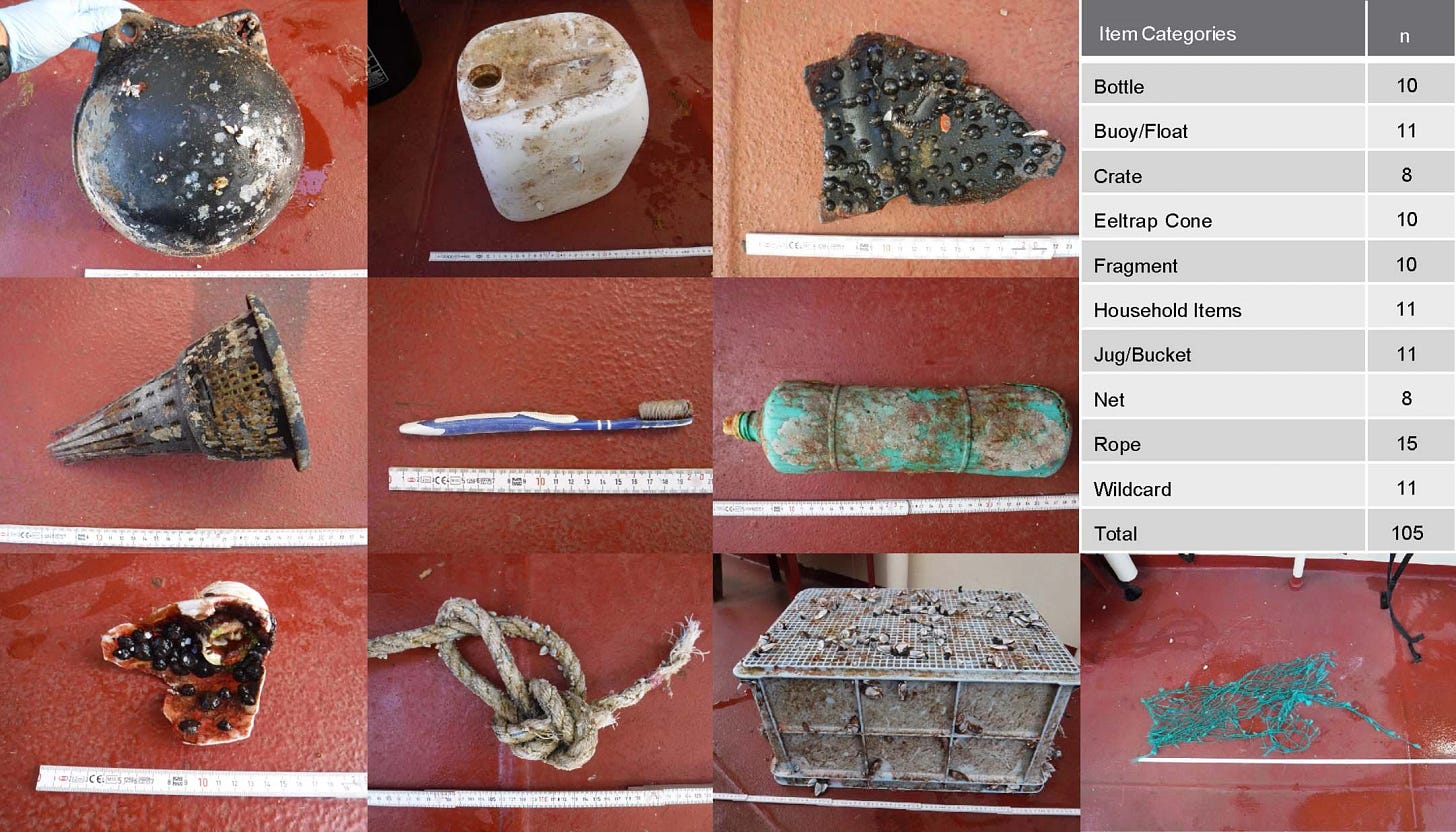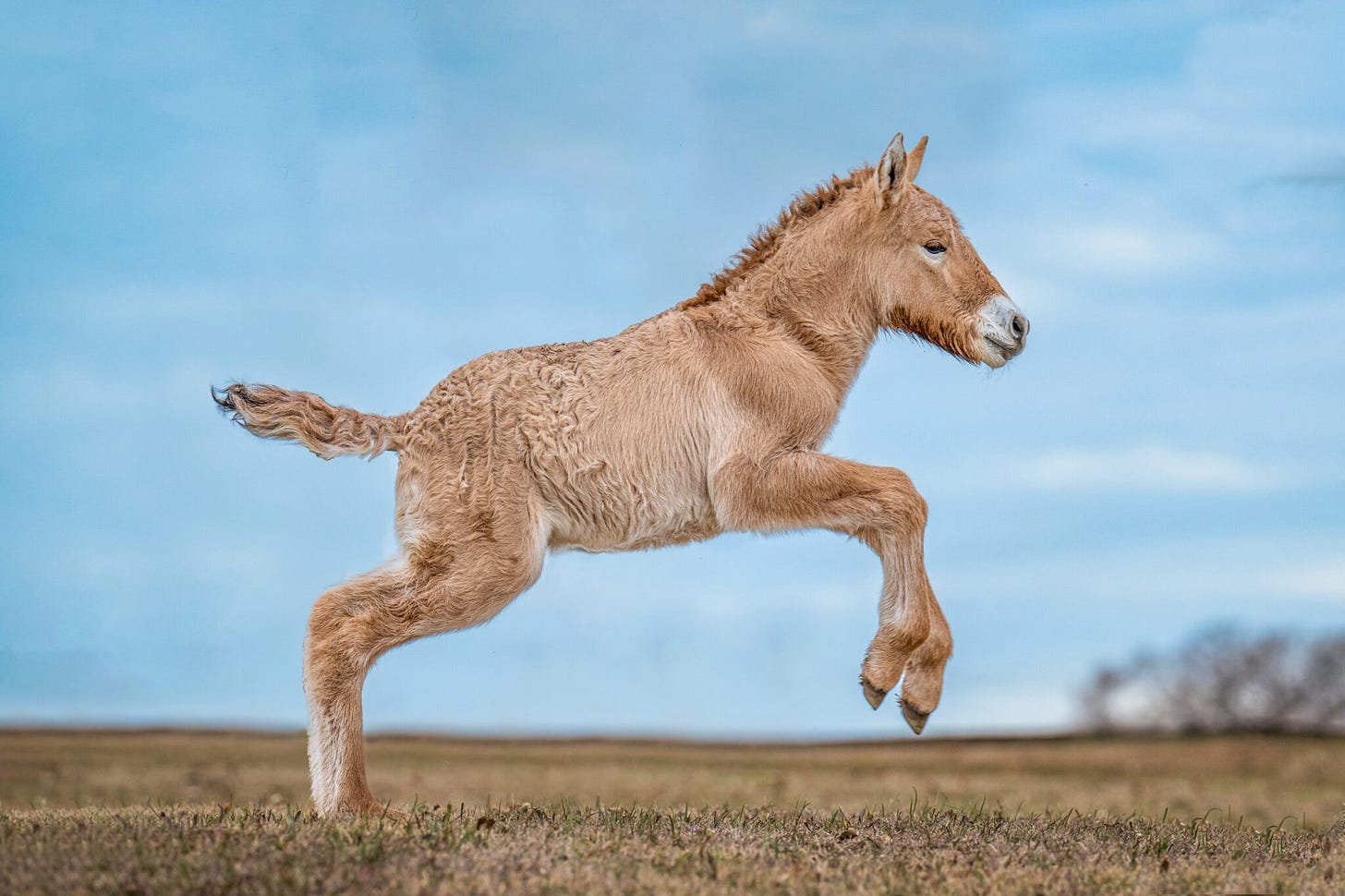The Weekly Anthropocene, April 26 2023
Strange species communities in the Great Pacific Garbage Patch, a fully autonomous battery materials-discovering lab, a cloned Przewalski's horse, and more!
The Great Pacific Garbage Patch

As is widely known, currents and gyres have accumulated about 80,000 tonnes of plastic debris in the Pacific Ocean to form the “Great Pacific Garbage Patch” between Hawaii and California. It’s somewhat less widely known that The Ocean Cleanup, a nonprofit, is starting to make serious progress on cleaning it up, already having removed 200,000 kilograms (200 tonnes) with their “Interceptor” system and planning to scale up to a trash-removing fleet.
Now, a new study has found a surprising array of small coastal marine invertebrates on samples of the debris collected by The Ocean Cleanup, breeding in place and intermingling with open-ocean invertebrates. Coastal species found included sponges, sea anemones, oysters, mussels, barnacles, and hydroids, while open-ocean species included crabs, amphipods, nudibranchs, and bryozoans. And they’re interacting to form new ecosystems on the floating trash; for example, coastal sea anemones were found to be eating open-ocean sea snails, a connection which likely wouldn’t have happened “naturally1.” Very little is known about these novel ecosystems or their overall effect on species populations or the oceans as a whole. The species communities colonizing plastic trash are quintessentially “Anthropocene” phenomena: existing on a substrate formed by human action, yet displaying unexpected natural diversity and richness.
It’s probably still a really good thing that The Ocean Cleanup is doing its work, even though some coastal species have managed to live on the Great Pacific Garbage Patch. Plastic debris (especially when broken down by wind and waves into tiny, swallowable pieces) has a lot of negative consequences to the marine ecosystem, including blocking sunlight to phytoplankton, bioaccumulating harmful pollutants and then poisoning the species that eat them, and causing seabirds to die of starvation by filling their stomachs without providing nutrition. The world will be a better place when the Great Pacific Garbage Patch is gone. Still, it’s really cool that life on Earth managed to find a way to cling on and develop new species communities even when faced with an unprecedented situation like a floating agglomeration of fossil fuel derivatives. Fascinating news!
California
The Lawrence Berkeley National Laboratory is developing an extraordinary automation of the entire process of scientific and technological discovery, already capable of creating novel useful materials 24-7 with no humans in the loop. At the Lawrence Berkeley National Laboratory, an AI is directing robots to conduct experiments to identify new high-functioning materials for battery electrodes, superconductors, and more. Here’s a description of how the autonomous “A-Lab” (pictured) works.
“The AI starts by coming up with a plausible way to synthesize a material, using its understanding of chemistry. It guides robotic arms to select among nearly 200 different powdery starting materials, containing elements such as lithium, nickel, copper, iron, and manganese. After mixing the precursors, another robot parcels out the mix into a set of crucibles, which are loaded into furnaces where they can be mixed with gases such as nitrogen, oxygen, and hydrogen. The AI then determines how long to bake the different mixes, the temperatures, drying times, and so on.
After the baking, a gumball-like dispenser adds a ball bearing to each crucible and shakes it to grind the new substance into a fine powder that’s loaded onto a slide. A robot arm then grabs each sample and slides it into an x-ray machine or other equipment for analysis. Results are fed back into the Materials Project database of materials structures and properties, and if the outcome isn’t what was predicted, the AI setup iterates the reaction conditions and starts anew.”
LBNL’s A-Lab has already produced several potentially useful novel materials (details not yet public), and researchers are continuing to add features and capabilities to the A-Lab system. Samsung is reportedly also setting up an automated lab for new electronics materials. This new method of discovery could substantially speed developments in battery technology, helping make the renewables revolution happen even faster. Longer-term, autonomous labs of this type could do amazing things for human civilization in general2!
European Union
The European Union is adopting a range of impressive legislation on key climate and environmental issues.
On April 18th, the European Parliament approved a landmark new climate law package, with several key components.
It expands the EU’s carbon market, the Emissions Trading System, from power generation and manufacturing sectors to fully cover aviation and shipping emissions as well. It also tightens the rules for the market, requiring power generators and other major polluters to reduce their emissions 62% by 2030. (A carbon market is basically an ever-lowering “cap” on how much carbon big polluters can legally emit. If one company is below the cap, they can “trade” or sell their unused legal emissions to another company that’s having more trouble complying. This creates a financial incentive to decarbonize more quickly-an emissions trading system for sulfur dioxide was how the USA got rid of acid rain).
It sets up a new, parallel carbon market from the emissions from gas-burning cars and fuel-burning furnaces to heat homes and buildings, to go into effect in 2027. To ensure that this won’t hurt the impoverished, the new also creates an 86.7 billion euro Social Climate Fund, starting in 2026, to compensate vulnerable consumers who may be affected by the resulting hire fuel prices. Europe is already transitioning very rapidly to EVs and heat pumps, so these ambitious programs, while great, might even be outpaced by events before they come into effect! They’ll certainly help put the last few nails in the coffin of fossil fuels.
The law package also creates the world’s first carbon border tax, levying a tax on imports of products made in higher-emitting facilities abroad.
And the EU is working to smooth out the path to getting new renewables built. On March 30th, the European Council and European Parliament3 announced a provisional agreement on upcoming new legislation that will set a target of 42.5% renewable energy by 2030 (that's overall energy consumption, not just electricity!). Furthermore, critically, the upcoming new law will also designate renewable energy projects as being "an overriding public interest," short-circuiting some legal objections, and allow member states to designate "renewables acceleration areas" with special extra-short and simple permitting processes to allow solar and wind farms to be built quickly.
On April 19th, the European Parliament passed the strongest law in history to fight global deforestation.
The new European Deforestation Regulation requires companies selling cattle, cocoa, coffee, palm oil, rubber, charcoal, soy and wood in the EU4 to submit due diligence reports showing that they verified the origin of their products as "not from deforested land" and "not violating the country of origin's human rights legislation."
EU authorities will conduct checks on a subset of products (randomized, with more checks for products from countries with higher deforestation issues), verify the product’s origin with satellite mapping and DNA analysis, and issue heavy fines (at least 4% of the company’s annual turnover in the EU) for companies found to be knowingly selling products sourced from deforestation.
This could have a really big positive effect for forests around the world5. The European Parliament estimates that EU consumption currently drives 10% of global deforestation, and the long-term effect could be bigger than that if it helps economically incentivize more sustainable producers of key products.
Cloning for Conservation

On August 2020, the world’s first cloned Przewalski’s horse was born, dubbed “Kurt.” Now, it’s been announced that on February 17, 2023, the second cloned Przewalski’s horse was born, dubbed “Trey,” in the first known case where there has been more than one cloned individual from an endangered species.
This “cloning for conservation” initiative is a partnership between the San Diego Zoo, commercial cloning company ViaGen, and genetic rescue nonprofit Revive & Restore6, and is intended to bring back lost genetic diversity from the species' past. The two cloned Przewalski’s foals are genetic twins, both of them clones of the same male Przewalski’s horse whose cells were cryopreserved in the 1980s in San Diego’s renowned “Frozen Zoo” of over 10,000 preserved cell specimens.
When they grow up, the two foals are intended to become breeding stallions to help their species' captive population become more healthy and diverse. Their descendants may one day join the reintroduced wild Przewalski’s horse population in Mongolia. This is a really cool use of advanced technology to help preserve a wild lineage!
This newsletter tries to avoid using the word “naturally” as it loses much of its meaning in a world where human civilization has changed fundamentals like atmospheric composition, but it’s still a useful shorthand for “without overt human intervention/influence.”
One could imagine this sort of evolving into a very cool, very Star Trek-like direction: perhaps one day a scientist could bring a novel virus sample into a pharmaceuticals-focused version of A-Lab and say “Computer, using your knowledge of mRNA vaccines and the array of biological components available to you, please synthesize a vaccine for this disease.”
There are several similar-sounding EU institutions (the European Council, the European Parliament, the European Commission…) with a role to play in European Union-wide legislation: see this Wikipedia article for a summary.
And products that are derivative of these products, like leather, paper, and chocolate.
Unfortunately, there is one really big loophole: the law explicitly doesn’t ban the EU importing wood pellets to be burned as biomass in energy plants, a highly carbon-intensive process that is already contributing to deforestation in Europe and the US. Still, that lacuna doesn’t nullify the positive effect of the new law in helping to protect forests being cut for beef, cocoa, palm oil, and many other products.
The same Revive & Restore that supports Ben Novak’s work to bring back the passenger pigeon, recently chronicled in The Weekly Anthropocene.





